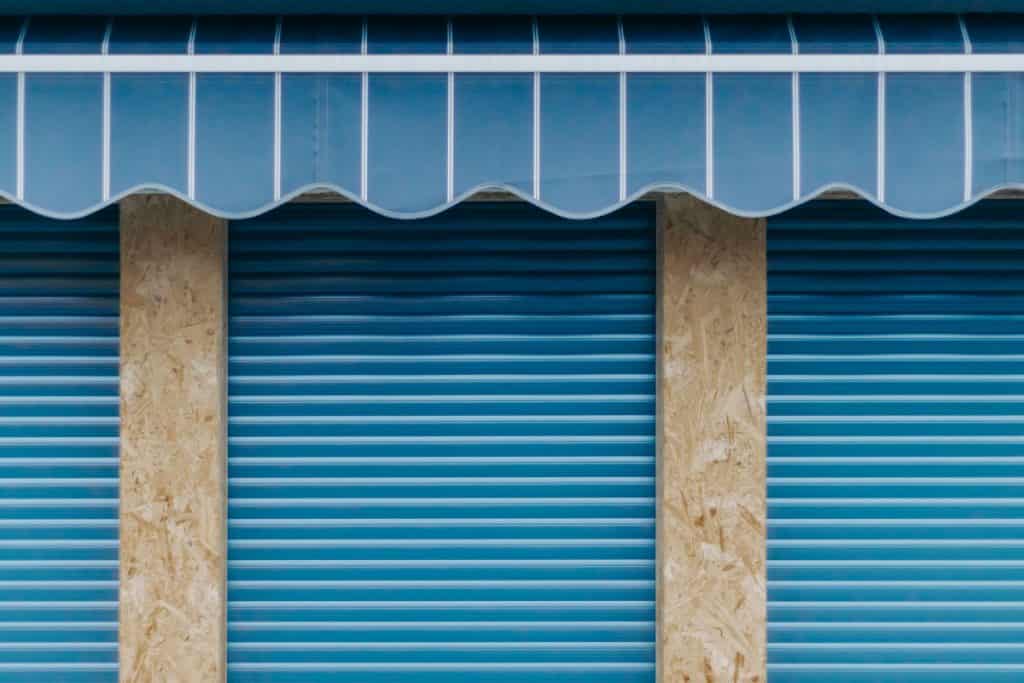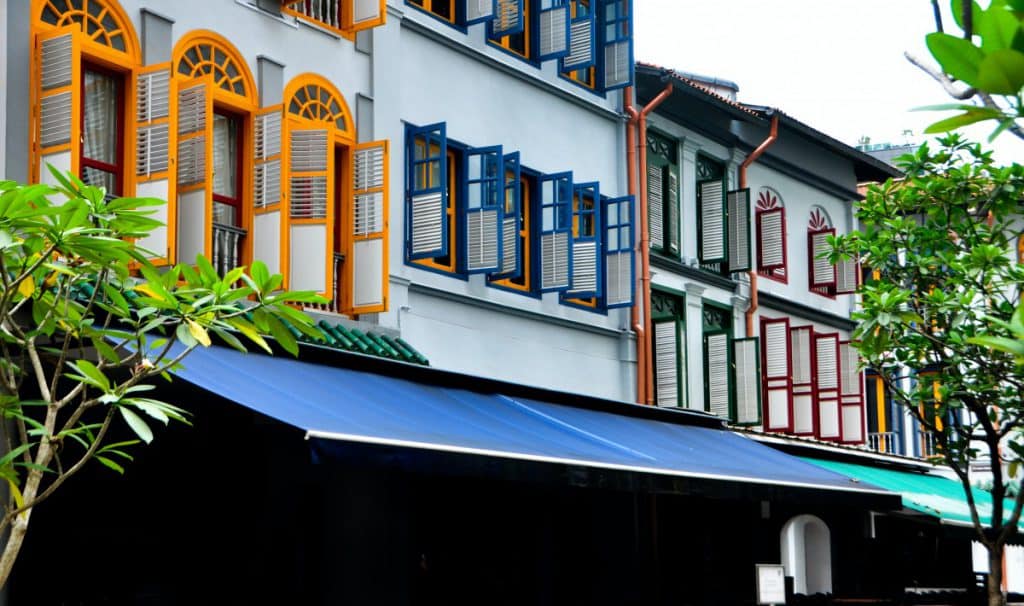Window awnings come in all sorts of shapes, sizes, and designs. More importantly, they come made from all kinds of materials, each with its own set of unique strengths. If you’re like many homeowners, you might be in the market for a waterproof or water-resistant awning.
The chances are high that you’ve heard about acrylic awnings being waterproof. But is that really the case? That’s what we’re going to find out in this article.
Here, we’re going to explore everything you need to know about acrylic awnings so that you can make a better-informed decision when choosing the awnings for your home.
Let’s get to it!

Are All Acrylic Awnings Waterproof?
At a minimum, all types of acrylic awnings are water-resistant but not necessarily waterproof.
What’s the difference? Well, water-resistant materials are tightly woven and dense, making it very difficult for moisture to get through. In cases of light exposure to water, they’ll do just fine in trying to stay dry.
Water-resistant acrylic awnings are those made from materials combining acrylic with something else. For example, you have awnings made from polyester-coated acrylic, blends of cotton and polyester coated with acrylic, and more. These combinations leverage the acrylic’s water resistance, but not to a point where they become waterproof.
So, for instance, a water-resistant awning will do just fine against light rain. It’ll keep itself dry, which also has the added benefit of preventing mould and mildew from growing.
Waterproof materials, however, allow absolutely no moisture to get through, as if it were a solid barrier against water.
The best example of that would be an awning made from 100% acrylic.
Which Acrylic Awnings Offer The Best Waterproofing?
Awnings, in general, already come with all sorts of options for materials. But even when you’ve decided on acrylic, there are several more options to choose from as well. If you’re looking for the acrylic awnings that offer the best waterproofing, nothing beats 100% acrylic materials.
You see, acrylic awning materials come in all sorts of combinations. You have blended materials, such as cotton with polyester that use an acrylic coat. These blends try to leverage the unique benefits of several materials put together. While the acrylic coat will provide added water-resistance, you won’t get the best waterproofing possible.
So, if you’re looking to get the full waterproofing benefits of an acrylic awning, your best choice is 100% acrylic fabric. They’ll prevent any moisture from getting through, which keeps you dry and comfortable when you’re sitting underneath the awning.
The waterproofing of 100% acrylic fabric also offers additional benefits, such as resistance to mould and mildew. That will make cleaning and maintaining the awning much easier, which then helps the awning last much longer overall.

How Long Does Acrylic Awning Waterproofing Last?
Most acrylic fabrics come with warranties of between five to ten years, so that should be a clear indication of how long the material’s qualities will last.
But if acrylic awnings are waterproof, why would the waterproofing ability wear out?
Well, here’s an important fact about acrylic materials that you must understand. The acrylic materials on awnings will expand and contract depending on the temperatures it’s exposed to. Hot days will see it expand more, and the opposite will happen whenever it gets chilly.
“After months and years of expansion and contraction, the acrylic materials will develop fine gaps between them. Those gaps will allow moisture and water to leak through the fabric, thereby making it no longer waterproof.“
Rest assured, there are some short- and medium-term fixes to extending the lifespan of your acrylic awning’s waterproofing. That includes patching any leaks and treating the acrylic material with a waterproofing solution.
How To Patch A Leak In An Awning
Thankfully, there are ways to patch a leak in an acrylic awning. The short- to medium-term fix is to simply apply an awning sealing tape to wherever the leak might be. That will keep the material together for a few months, at least, and prevent the leak from getting worse.
It is entirely possible for you to use regular duct tape to do this, but that might make your awning look a little less pleasing to the eye.
Instead, you could look for specialized tape that’s designed explicitly for awning repair, especially one that’s see-through or matches your awning’s colour.
Again, that fix may only work in the short- or medium-term. For the long haul, you might want to consider replacing the awning, especially if it’s been in use for many years.
How To Treat Acrylic Awnings
Over time, the waterproof qualities of the acrylic material will start to degrade. If there are no significant tears or leaks, you can treat the material and renew its waterproofing. All you’ll need to do is buy a waterproofing coat from your local hardware store or online.
The waterproofing spray typically comes in the form of a spray bottle. Before using it, you must clean the awning material thoroughly to remove any dirt or stains.
Remember: you’re going to be applying several layers of waterproofing, which is why the surface must be absolutely clear before you begin.
Once you’re ready, you’re going to spray the surface of the awning with your first layer of waterproofing. A thin layer is all that’s necessary, so if the solution is running down the surface, you’ve sprayed too much.
You’ll need to let the first layer dry completely before applying the following one. Then, you’ll repeat the process several times.
“Always remember to follow the manufacturer’s instructions to the tee. That way, you can rest assured that you’ve applied the waterproofing treatment correctly and can enjoy all of the benefits it offers.“
What About Snow And Ice?
If you live in a colder climate or one that has intense winter seasons, then you should be concerned about snow and ice on your awnings. Besides the moisture, you also have the issue of wind blowing strongly against the awning, as well snow building up on top of it.
Acrylic awnings are probably the best option when it comes to resisting snow and ice. For starters, acrylic is a heavy-duty material that’ll stand up to the windy conditions that occur in colder climates.
Still, the wind isn’t the only thing that you have to worry about when it comes to awnings in cold climates. You’ll also have to think about snow building up on the awning and adding too much weight.
For the best results, you’ll want an acrylic awning that’s retractable and perhaps of a shape where snow and ice can easily fall off.
Lastly, acrylic awnings are also waterproof. That will prevent the moisture from snow and ice from absorbing into the material, making it even heavier than it already is. As a side benefit, the waterproof nature of acrylic will also prevent mould and mildew from growing on the awning.

Acrylic Awnings Vs Vinyl – Which Offers The Best Waterproofing?
When it comes to waterproofing, acrylic and vinyl awnings are at a tie. Both of them are fantastic at keeping water away. So, they both make for good options when it comes to awnings in cold, wet, and humid environments.
If you’re struggling to choose between acrylic and vinyl, waterproofing isn’t what you should be looking at (since they’re both great at that). Instead, you must understand that they each have their fair share of pros and cons.
For example, vinyl awnings tend to be heavier and less breathable. That means there’s less ventilation and comfort while you’re standing underneath it. On the other hand, acrylic materials are known for providing added ventilation, heat dissipation, and overall comfort.
Still, when it comes to waterproofing, they both do an excellent job in staying dry. That also means both acrylic and vinyl awnings are also better at avoiding stains and preventing mould and mildew growth.
Polyester Or Acrylic Awnings – Which Are Better For Waterproofing?
Polyester is another very popular material when it comes to awnings. It’s a synthetic material that offers plenty of benefits, including the ability to withstand almost any weather. More importantly, it resists humidity, dries very quickly if it ever gets wet. Naturally, it prevents mould and mildew from growing.
However, if you’re comparing polyester awnings to acrylic ones based on waterproofing, then acrylic is definitely the superior material.
Even though acrylic and polyester both dry out very quickly, acrylic is much more resistant to water and moisture in the first place.
Although only somewhat related to waterproofing, acrylic awning materials are also more colour-fast than polyester. That means no matter what colour or design you might have, an acrylic awning will take much longer to fade away from exposure to the weather.
Don’t worry if you can’t decide on one over the other. You also have the option of getting an awning made of a combination of acrylic and polyester. While that might not provide you with 100% waterproofing, it does give you a chance to enjoy the best of both worlds.
Alright, that’s it for this article guys, if you found it useful then a share on social media or your website would be cool!
All the best
Steve
ps here’s a few articles related to this one you might find interesting:
Are Aluminum Awnings Noisy – We Looked at 5 Models!
Do Awnings Get Hot? 7 Popular Materials Reviewed!
How Much Are Custom Awnings? (3 popular examples with images)

